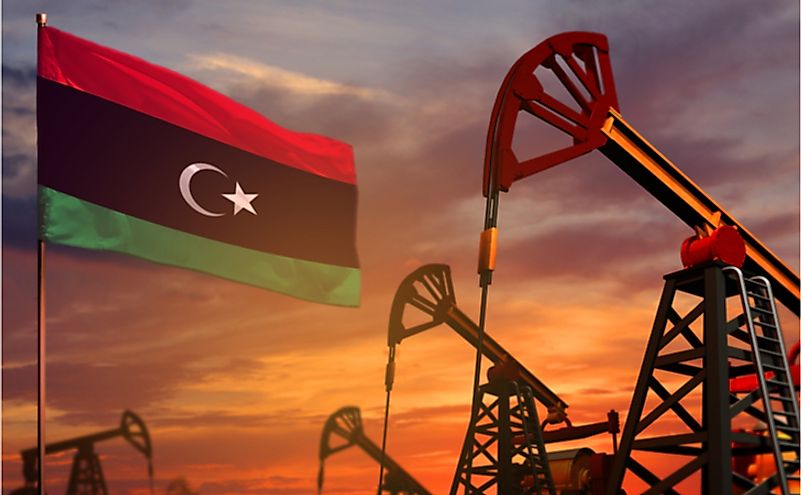What Are The Major Natural Resources Of Libya?

Libya is a country situated in the north of Africa. It is bordered to the south by Chad and Niger, to the northern part by the Mediterranean Sea, to the east by Sudan and Egypt, and the west by Algeria and Tunisia which is a fellow OPEC member. The nation is comprised of the Tripolitania, Cyrenaica, and Fezzan historical regions and is ranked 16th in terms of land area with a vast majority of the territory sitting on the Sahara Desert. The nation is home to an estimated 5,095,000 people who live mainly on land bordering the Mediterranean Sea. Tripoli is the country's capital and one of the largest population centers in the country as it hosts up to a quarter of the entire nation's population. Despite sitting on unproductive desert land, the country is endowed with many natural resources that are vital to the nation's economy, and they include; oil, natural gas, gypsum, iron, potassium, magnesium, phosphate silica, and limestone among others. The nation has a GDP of $79,595 billion and is mainly reliant on oil exports.
Oil
Libya has some of the largest oil reserves in the world. It is currently ranked 10th highest globally and 1st in Africa. The nation is a major petroleum supplier to European countries. Oil production in the country is currently estimated to be 1 million barrels per day, but the amount of oil production has been observed to vary due to the current ongoing internal conflict and political instability. The nation embraced oil production in 1959 following successful drilling. The nation was previously one of the poorest in the world before it rose to become one of the biggest oil producers. By 1969, Libya produced about 3 million barrels of oil per day. Oil production gradually dropped over the following years due to international disputes with major global economies such as the US. Oil production remained substantial under the dictatorship of Muammar Gaddafi, who was later removed from power during the Libya Civil War in 2011 in part due to the unequal distribution of wealth gained from the sale of oil. Oil production was severely affected by the Civil war which further affected production output. Despite the ongoing conflict, oil exploration has continued, although at a slow rate. The country has 10 billion-barrel oil fields and 21 giant gas fields. The nation had a total of 162 oil wells and 31 oil rigs in 2014. The country is still thought to hold massive additional oil reserves as the vast desert landscape remains unexplored. The interim government is also considering embracing modern extraction techniques which could potentially add an estimated 775,000 barrels per day to the nation’s overall daily production.
Natural Gas
Libya is ranked 21st in terms of proven reserves in the world. The reserves are estimated to hold up 53,113.0 billion cubic feet of natural gas. The country was among the first gas exporters in the world when its LNG plant came into operation in 1971. The nation primarily exports its gas through pipelines with the main market being Italy. A recent offshore gas discovery such as the Bahr al-Salam is expected to boost production with an additional 400 million cubic feet of gas. The Bahr al-Salam well is located 74 miles north of Tripoli and is estimated to contain 260 billion cubic feet of natural gas. The nation’s gas exploration and production capacity have been severely hampered by political instability in the nation.
Iron
Libya has huge iron ore deposits in Wadi ash Shati which is near Sabha in Fezzan. The deposit occupies an area of 1,544 square miles and holds up to 5 billion metric tons of different types of iron, which include 900 million metric tons at Tharot lens, 750 million metric tons at Arrwisa lens and 500 million metric tons of Ashkeda lens. The nation’s iron ore deposits are the third largest on the continent. Strip mining is the preferred extraction method. Operations at the mine were affected following divestment by US companies in the 1980s. Efforts are, however, underway to restart operations at the mine. Once optimal operation levels are attained, the mine is expected to contribute up to $260 million in revenues.
Gypsum
Libya is estimated to have 9.2 million tons in gypsum resources. The deposits are scattered across 18 locations in the country. The deposits are part of the Bir Al Ghanam formation with some of the most prominent deposits found in Benghazi, Al Jabr, the Gulf of Sirte and Al Gharbi. It is reckoned that the Jefren deposit has the world’s highest concentration of pure gypsum.
Silica
The Idri region in southeastern Libya has an estimated 1.8 million tons of proven reserves and 1.83 million tons of probable silica reserves. Silica sand extracted from the area is utilized in the manufacturing of optical lenses, fiberglass, and casting molds.
Phosphate
Libya has significant phosphate deposits, nodules of the mineral can be found in the Melaz Suqran Formation at the Tikumit area. The nodules consist of calcite, apatite, limonite, and quartz. The phosphate deposit in the area is estimated to be 109,000 tons.
Limestone
Libya has significant limestone deposits which are used to drive the building and cement industries in the country. Deposits include the Al Hilal Formation near the village of Ras Al Hilal which has calcareous shale as well as argillaceous limestone. Al Jabal Al Akhdar deposits are found in Cyrenaica in the northeastern part of the nation. The Al Jabal Al Akhdar deposits are composed of Upper Cretaceous and Tertiary marine deposits. Lower Cretaceous and Jurassic marine deposits are also found in exploratory oil wells.
Future Economic Plans
Libya is currently considering diversifying from the hydrocarbon-based economy. The diversification plans involve encouraging the extraction of alternative minerals such as iron and gypsum. The nation is yet to realize the benefits of the full utilization of its resources due to ongoing political instability.











